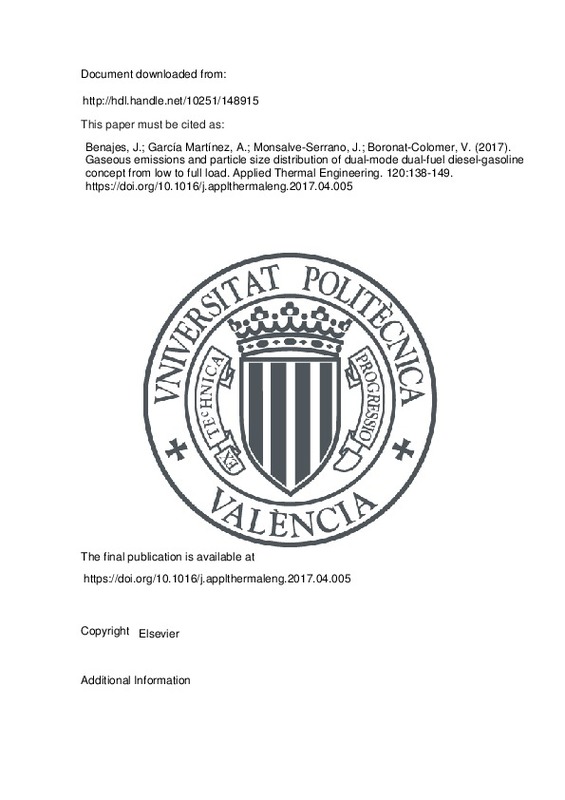JavaScript is disabled for your browser. Some features of this site may not work without it.
Buscar en RiuNet
Listar
Mi cuenta
Estadísticas
Ayuda RiuNet
Admin. UPV
Gaseous emissions and particle size distribution of dual-mode dual-fuel diesel-gasoline concept from low to full load
Mostrar el registro sencillo del ítem
Ficheros en el ítem
| dc.contributor.author | Benajes, Jesús
|
es_ES |
| dc.contributor.author | García Martínez, Antonio
|
es_ES |
| dc.contributor.author | Monsalve-Serrano, Javier
|
es_ES |
| dc.contributor.author | Boronat-Colomer, Vicente
|
es_ES |
| dc.date.accessioned | 2020-07-30T03:35:55Z | |
| dc.date.available | 2020-07-30T03:35:55Z | |
| dc.date.issued | 2017-06-25 | es_ES |
| dc.identifier.issn | 1359-4311 | es_ES |
| dc.identifier.uri | http://hdl.handle.net/10251/148915 | |
| dc.description.abstract | [EN] Low temperature combustion concepts are in focus of study nowadays as a method to avoid the NOx-soot trade-off existing with conventional diesel combustion. One of the most promising strategy is known as reactivity controlled compression ignition because of its high thermal efficiency and the ultra-low nitrogen oxides and soot emissions. However, this concept presents several challenges such as the high levels of carbon monoxide and unburned hydrocarbons promoted at low load and unacceptable levels of pressure rise rate at high load. Therefore, to mitigate these shortcomings the dual-mode dual-fuel concept, combining reactivity controlled compression ignition and diffusive dual-fuel diesel-gasoline combustion, has been developed. Total number of particles is also limited by the emission standards. Previous studies focused in particles emissions carried out by the research community present particle size distribution, composition and mass of the particles on reactivity controlled compression ignition combustion mode. Additional studies were carried out in order to identify the components of these particles, being partially formed of volatiles, and reflects that particles are smaller than at conventional diesel combustion, presenting higher number of particles from nucleation mode than from accumulation mode. Dual-Mode Dual-Fuel concept may present a different behavior for particle distribution with respect to the conventional diesel combustion or the traditional low temperature concepts due to the nature of the particles. The objective of the present study is to measure the particle size distribution as well as gaseous emissions of this new Dual-Mode Dual-Fuel concept from low load to full load for a representative engine speed of 1200 rpm. Main results of this study suggest that Dual-Mode Dual-Fuel concept promotes higher quantity of particles than conventional diesel combustion despite of providing less smoke. In addition, nucleation mode particles dominate the particle size distribution for the new combustion concept at low load and moves towards accumulation mode domination at full load. (C) 2017 Elsevier Ltd. All rights reserved. | es_ES |
| dc.description.sponsorship | This investigation has been funded by VOLVO Group Trucks Technology. The authors also acknowledge the Spanish economy and competitiveness ministry for partially supporting this research (HiReCo TRA2014-58870-R). The predoctoral contract of the author V. Boronat (FPI-S2-2017-2882) is granted by the Programa de Apoyo para la Investigacion y Desarrollo (PAID) of the Universitat Politecnica de Valencia. The author J. Monsalve-Serrano acknowledges the financial support from the Universitat Politecnica de Valencia under the grant "Ayudas Para la Contratacion de Doctores para el Acceso al Sistema Espahol de Ciencia, Tecnologia e Innovacion". | es_ES |
| dc.language | Inglés | es_ES |
| dc.publisher | Elsevier | es_ES |
| dc.relation.ispartof | Applied Thermal Engineering | es_ES |
| dc.rights | Reconocimiento - No comercial - Sin obra derivada (by-nc-nd) | es_ES |
| dc.subject | Reactivity controlled compression ignition | es_ES |
| dc.subject | Dual-fuel combustion | es_ES |
| dc.subject | Particle matter | es_ES |
| dc.subject | EURO VI emissions | es_ES |
| dc.subject | Low temperature combustion | es_ES |
| dc.subject.classification | MAQUINAS Y MOTORES TERMICOS | es_ES |
| dc.title | Gaseous emissions and particle size distribution of dual-mode dual-fuel diesel-gasoline concept from low to full load | es_ES |
| dc.type | Artículo | es_ES |
| dc.identifier.doi | 10.1016/j.applthermaleng.2017.04.005 | es_ES |
| dc.relation.projectID | info:eu-repo/grantAgreement/MINECO//TRA2014-58870-R/ES/REDUCCION DE LAS EMISIONES DE CO2 EN VEHICULOS PARA TRANSPORTE USANDO COMBUSTION DUAL NATURAL GAS-DIESEL/ | es_ES |
| dc.relation.projectID | info:eu-repo/grantAgreement/UPV//FPI-S2-2017-2882/ | es_ES |
| dc.rights.accessRights | Abierto | es_ES |
| dc.contributor.affiliation | Universitat Politècnica de València. Departamento de Máquinas y Motores Térmicos - Departament de Màquines i Motors Tèrmics | es_ES |
| dc.description.bibliographicCitation | Benajes, J.; García Martínez, A.; Monsalve-Serrano, J.; Boronat-Colomer, V. (2017). Gaseous emissions and particle size distribution of dual-mode dual-fuel diesel-gasoline concept from low to full load. Applied Thermal Engineering. 120:138-149. https://doi.org/10.1016/j.applthermaleng.2017.04.005 | es_ES |
| dc.description.accrualMethod | S | es_ES |
| dc.relation.publisherversion | https://doi.org/10.1016/j.applthermaleng.2017.04.005 | es_ES |
| dc.description.upvformatpinicio | 138 | es_ES |
| dc.description.upvformatpfin | 149 | es_ES |
| dc.type.version | info:eu-repo/semantics/publishedVersion | es_ES |
| dc.description.volume | 120 | es_ES |
| dc.relation.pasarela | S\332941 | es_ES |
| dc.contributor.funder | Volvo Group Trucks Technology | es_ES |
| dc.contributor.funder | Universitat Politècnica de València | es_ES |
| dc.contributor.funder | Ministerio de Economía y Competitividad | es_ES |







![[Cerrado]](/themes/UPV/images/candado.png)

